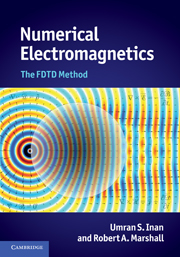Book contents
- Frontmatter
- Contents
- Preface
- 1 Introduction
- 2 Review of electromagnetic theory
- 3 Partial differential equations and physical systems
- 4 The FDTD grid and the Yee algorithm
- 5 Numerical stability of finite difference methods
- 6 Numerical dispersion and dissipation
- 7 Introduction of sources
- 8 Absorbing boundary conditions
- 9 The perfectly matched layer
- 10 FDTD modeling in dispersive media
- 11 FDTD modeling in anisotropic media
- 12 Some advanced topics
- 13 Unconditionally stable implicit FDTD methods
- 14 Finite difference frequency domain
- 15 Finite volume and finite element methods
- Index
15 - Finite volume and finite element methods
Published online by Cambridge University Press: 05 June 2012
- Frontmatter
- Contents
- Preface
- 1 Introduction
- 2 Review of electromagnetic theory
- 3 Partial differential equations and physical systems
- 4 The FDTD grid and the Yee algorithm
- 5 Numerical stability of finite difference methods
- 6 Numerical dispersion and dissipation
- 7 Introduction of sources
- 8 Absorbing boundary conditions
- 9 The perfectly matched layer
- 10 FDTD modeling in dispersive media
- 11 FDTD modeling in anisotropic media
- 12 Some advanced topics
- 13 Unconditionally stable implicit FDTD methods
- 14 Finite difference frequency domain
- 15 Finite volume and finite element methods
- Index
Summary
In this chapter we introduce the framework for two alternative methods, the finite volume (FV) and finite element (FE) methods, as they apply to time domain electromagnetic problems. These two methods are particularly useful in cases where the geometry of the problem involves complicated, curved surfaces, the scattering from which we would like to model with high accuracy. In such scenarios, the FDTD method's inherent “staircasing” of the grid cells means that those curved surfaces are not well described in the model.
In Section 15.2 we will introduce the finite volume method, and in Section 15.3 we will discuss the finite element method. We conclude the chapter with a brief introduction to the discontinuous Galerkin method, using features of both finite volume and finite element methods. Our intention here is not to provide a full treatment of these methods, but simply to introduce them to the student, in order to show their relationship to the FDTD method, and to clarify the conditions under which these alternative methods might be used. As such we provide only brief introductions to the FV and FE methods and refer the readers to other materials for a full treatment. Before describing these methods, we provide an introduction to advanced grid techniques, which will be required for both of these methods.
Irregular grids
The FDTD method as we have described it so far involves a regular, orthogonal grid of identical cells with dimensions Δx, Δy, and Δz, in Cartesian coordinates.
Information
- Type
- Chapter
- Information
- Numerical ElectromagneticsThe FDTD Method, pp. 356 - 384Publisher: Cambridge University PressPrint publication year: 2011
